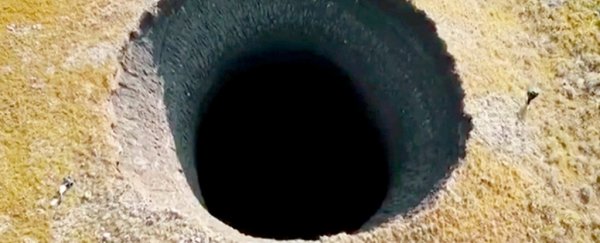A bubble of methane gas, swelling beneath Siberia's melting permafrost for who knows how long, has burst open to form an impressive 50-metre-deep (164-foot-deep) crater.
The giant hole was first spotted by a TV crew flying overhead, and, according to The Siberian Times, when scientists went to investigate, they found chunks of ice and rock thrown hundreds of metres away from the epicentre.
The once secure pocket of methane was long gone, and only a giant void remained where it used to be.
Giant new 50-metre deep 'crater' opens up in Arctic tundra. Blocks of soil and ice thrown hundreds of metres from epicentre of the funnel at the Yamal peninsula https://t.co/2fTA8GZRS4 #YamalFunnels2020 pic.twitter.com/t5CJRVwuRS
— The Siberian Times (@siberian_times) August 29, 2020
It's not clear when the hole formed, or if climate change played a role, but in 2014, something weirdly similar (and equally disturbing) was also spotted on the Yamal peninsula in northwest Russia, after a series of unusually warm summers.
In fact, this is at least the 17th such 'funnel' discovered to date in the region and the largest of its kind in recent years.
The giant holes are thought to result from the sudden collapse of hills, or swellings of tundra, which themselves form when melting permafrost causes a build-up of methane beneath the surface.
Thanks to anthropogenic climate change, the Arctic is undergoing a rapid collapse of its permafrost, and while the funnel phenomenon is probably influenced by these changes, there are still very few studies investigating how climate change specifically induces their collapse.
That could be quite an oversight. Methane is 84 times more potent as a greenhouse gas than carbon dioxide, so the release of vast stores of this gas could kickstart a vicious feedback loop that stands to make the current global climate crisis even more dire.
Analysing historical imagery going back to the 1970s, a 2017 study found Siberian funnels have expanded in recent years, and this suggests melting permafrost is at least partly driving these sorts of collapses and prompting the release of Arctic methane stores.
That same year, another study found 7,000 gas pockets under the Yamal peninsula, right where the newly discovered funnel was found.
Still, we don't know if these gas pockets are new or not. Permafrost makes up roughly two thirds of Russian territory in some of the most remote and inaccessible parts of the world, and we simply don't have enough eyes on these areas.
"The frost heaving that precedes a crater usually happens quite quickly, over one to two years, and this sudden growth is hard to observe, so almost all craters were discovered after everything had already happened," researcher Evgeny Chuvilin, who studies permafrost melt at the Skolkovo Institute of Science and Technology, explained earlier in the year.
"We have only piecemeal evidence from locals who say they heard a noise or saw smoke and flames. Plus, a crater turns into a lake in another one to two years, which is then hard to distinguish from common thermokarst lakes in the Arctic."
Apart from the incredible amount of methane this region of the world could one day spew, scientists are also worried what will happen if melting permafrost unleashes ancient diseases we know nothing about.
In fact, this might already be happening. In 2016, an outbreak of anthrax, which killed a 12-year-old boy, was traced back to thawing permafrost, which leaked the old bacterium into the region's water and soil.
Nor is that the only dangerous consequence. Just this year, melting permafrost caused the worst fuel spill in Arctic history, and scientists are worried by the location of many more fuel pipes and structures, with the Yamal peninsula particularly at risk.
Even if it doesn't release a virus or cause an oil spill, a gaping chasm suddenly appearing in the ground is usually not a good sign.
Researchers investigating the peninsula's newly emerged hole told local media this particular void is unique, although the team wouldn't disclose any more information about it just yet.
